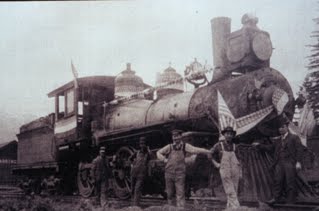ABOUT THE TOWN OF DARRINGTON
"A sense of security seemed to come from these mountains; it was like living in the hollow of the cupped hand of God." Jean Bedal Fish
1. How did Whitehorse Mountain get its name?
There are several stories, the most common is that when viewed from the north (a good place is Highway 530 about 2 miles north of town) the viewer can see a horse’s head. The ears are the peaks of the mountain, the horse is facing roughly east. Another common story relates that early pioneer Fred Olds lost his white horse on the mountain. A neighbor remarked to him that a snowfield on the mountain “sure looks like your old white horse.” The beauty of the mountain is indisputable, regardless of which story is correct. (Source; History of Snohomish County Vol. 1, edited by Wm. Whitfield 1926)
2. How did Gold Hill get its name?
Gold Hill, or Gold Mountain, is named for the many mining claims that were located on this prominent feature southeast of town, across the Sauk River. In 1900 there were about 100 claims located principally on the northern end of the mountain. Evidence of this early mineral exploration can still be found. (Source; History of Snohomish County Vol. 1, edited by Wm. Whitfield 1926)
3. How did people get to Darrington before the Highway?
There was a rough track between Arlington and Darrington along the North Fork of the Stillaguamish River as early as 1889, but the first freight to arrive via Arlington on 4 wheels was in 1899. Prior to this people and goods were transported by canoe, foot and packhorse. In 1922, Standard Oil opened the first gas station, “an auxiliary supply station for gasoline and stove oil”. The road was still gravel between Oso and Darrington into the 1940’s and was administered by the State of Washington as a secondary Highway beginning in 1957. (Sources; History of Snohomish County Vol. 1, edited by Wm. Whitfield 1926, WSDOT records and Darrington, Mining Town/Timber Town by Elizabeth S. Poehlman)
4. When was the first school built in Darrington?
The first school was built in 1893. In September 1892, a petition was filed with the Snohomish County superintendent. The petition was heard on October 22, 1892, and approved, and District No. 64 was born. To help the new district get started, the county gave the board of directors $94.80. (Source; History of Snohomish County Vol. 1, edited by Wm. Whitfield 1926)
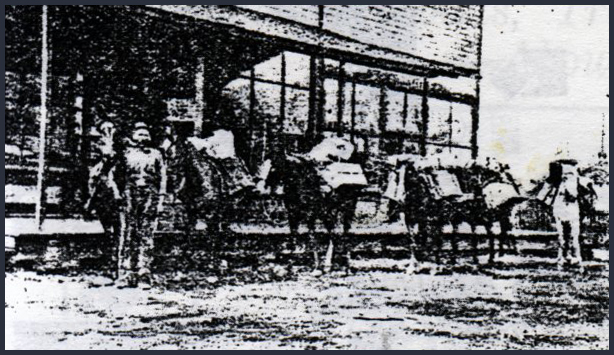
5. When did Darrington get its reputation as a great place to enjoy outdoor activities?
Always known for its spectacular scenery, the first tourism brochure was published around 1925 by the Darrington Improvement Club, it was titled, “Darrington, Where the trails begin”.
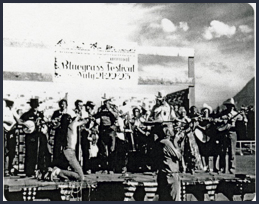
6. How did Darrington become famous for Bluegrass music?
In the 1950’s a group of local musicians with roots in North Carolina would get together for “Jam Sessions” at the Community Center every month. As the sessions grew the Darrington Bluegrass Association was formed in order to bring nationally recognized acts to town. The founders of the Bluegrass
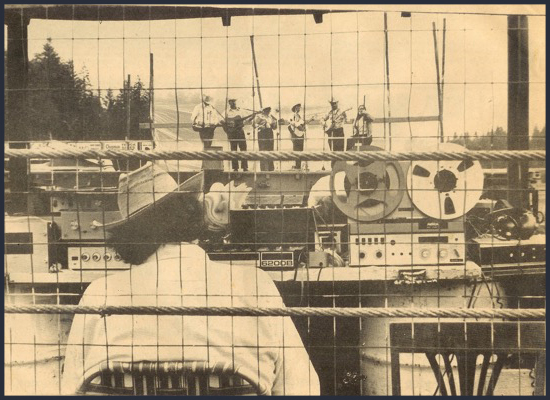
Festival, Bob Fisher, Grover Jones, Louie Ashe, O.C. Helton, Roy Morgan (pictured below, left to right) started a bluegrass band called The Whitehorse Mountaineers in the mid-1970s. The band grew out of local jams by transplanted Tarheels in Darrington that started drawing so many people they decided to host the first annual Darrington Bluegrass Festival in 1977 at the rodeo grounds.
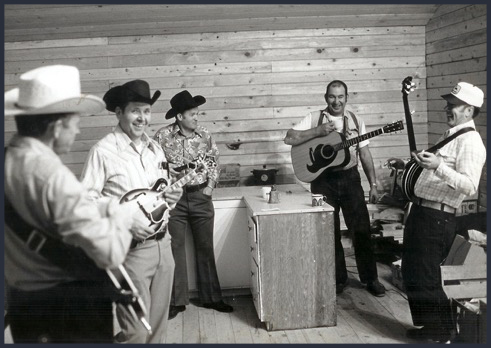
The first stage was a flatbed trailer set up at the Darrington Rodeo Grounds. Sam and Bertha Nations met and married in North Carolina and moved to Darrington in the 1940s. They called their band The Combinations. Like their friends in The Whitehorse Mountaineers, Sam and Bertha were also founding members of the Bluegrass and Country Musicmakers Association, the nonprofit which runs the festival to this day, 40 years later. Although Sam passed away in the year 2000, Bertha continues to play, bringing the latest version of The Combinations to the festival’s stage this year.
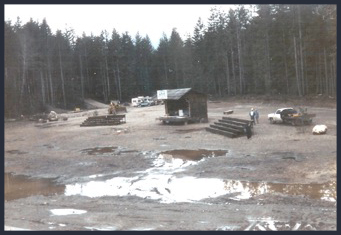
In the 1980s, the land immediately east of the rodeo grounds became available, so the Bluegrass and Country Musicmakers Association purchased it and started working to make it an outdoor amphitheater. The Darrington Bluegrass Festival now had its own home. This photo shows the portable stage that had been used at the rodeo grounds, placed in its new home at the bluegrass grounds while the site was still under construction.In the late 1980s, a new, bigger stage was built in the style of a log cabin home, similar
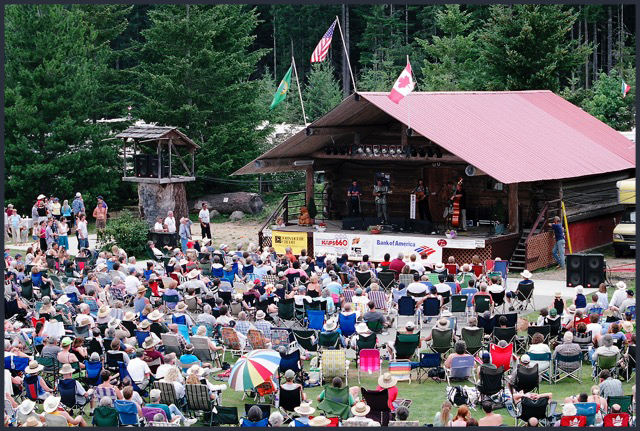
to country and bluegrass venues in the South. Musicians were now better protected from the elements and they had a room backstage to hang out in before their time to play. That stage has featured some national bluegrass legends, including Bill Monroe.
Other Historic Photos credited to Darrington Historical Society Archive unless photographer/creator is identified
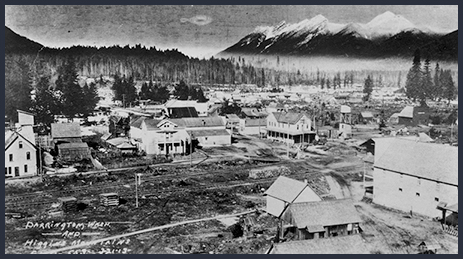 Darrington 1913 By Ward Woodward
Darrington 1913 By Ward Woodward
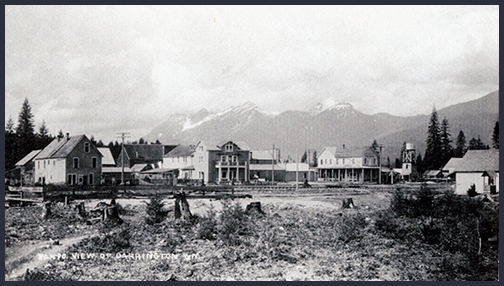 Darrington 1912 photographer unknown
Darrington 1912 photographer unknown
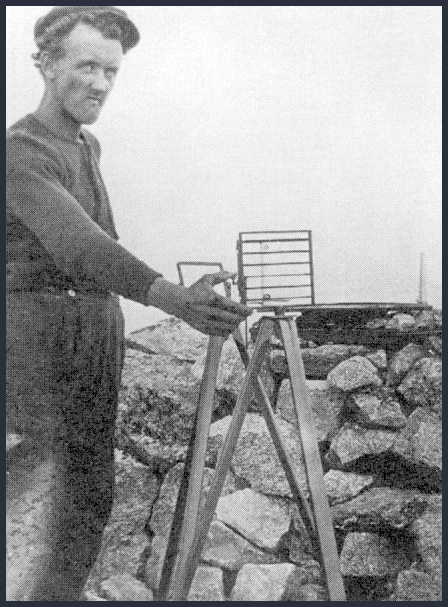
Bruseth Painting digital photo of Nels Bruseth painting of Sloan Peak from Sunup Lake (original painting in Darrington Ranger Station)
Nels Bruseth Pugh 1918 (Photographer unknown) Nels Bruseth in September 1918 standing on top of Pugh Mountain with the heliograph, the device he used to signal fire information to Forest Service crews below. At this time, Bruseth was serving as the fire lookout on Pugh's 7,200-foot summit while camping in a tent. Later, he helped build a lookout there, one of the first in the area.
Nels Bruseth Jumbo by Phil Berquist "Old Man of Jumbo Mountain," a rock formation on Jumbo that looks like the head of a man. In this photo the Old Man is looking off to the left of the photo. A real man is standing beneath the Old Man on the snow. The real man is Nels Bruseth, according to a handwritten caption on back. That same note says Phil Berquist took the photo. It also has the Harold J. Engles stamp on it, indicating this was Harold's copy of Phil's shot of Nels on Jumbo.
Nels Bruseth Brief Biography
Nels Bruseth (1886-1957) was born in 1886 in Stanwood, Washington. He joined the United States Forest Service in 1916. He was a trail worker, then a lookout on Mt. Pugh. He later became a Foreman, and then the assistant to the District Ranger. He retired from the Forest Service in 1951. He was among the first to survey the Cascade Crest trail. In 1921 he married Beate Faulk, and they honeymooned at the lookout on Mt. Pugh. Bruseth was also an amateur painter, anthropologist, photographer, botanist, geologist, and musician. In 1926, he published a small book, Indian Stories and Legends of the Stillagaumish and Allied Tribes. He spent much of his adult life in Darrington, Washington. He wrote numerous articles about forestry, recreation, the town of Darrington, and local history for the Arlington Times during the 1940s and 1950s. He died on March 24th 1957. (source; University of Washington Digital Libray, Guide to the Nels Bruseth Writings, Correspondence and Scrapbook of Botanical Specimens)
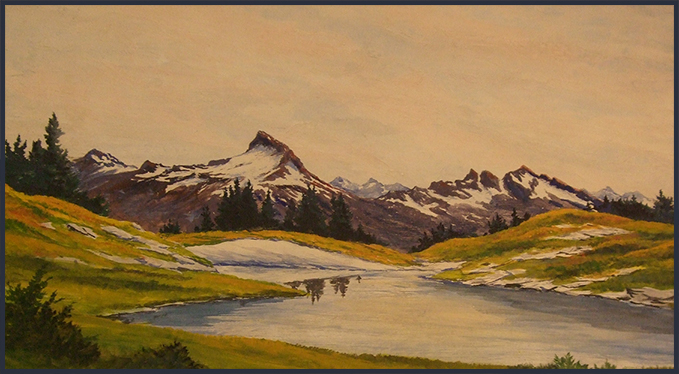
He was a prolific artist and his paintings of the mountains and scenery around Darrington can be found in public and private collections throughout the northwest.
He was a founding member of the Darrington Improvement Club, and was instrumental in the development of the Darrington Archery grounds and Ski Hill (now defunct) which included a Nordic style ski jump. The Nels Bruseth Memorial Garden, directly across SR 530 from the Darrington Ranger Station preserves his memory and his interest in the history and culture of the Sauk-Suiattle Indian Tribe. Four canoes are displayed there, one reported to have been made by Nels. He is remembered in many local histories, including Darrington Mining Town/Timber Town by Elizabeth Poehlman and Switchbacks by Andy Holland. His writings are preserved in collections housed by the University of Washington and the Darrington Historical Society.
His book Indian Stories and Legend of the Stillaguamish, Sauks and Allied Tribes is available from the Darrington Historical Society and is on sale at Mt Loop Books and Coffee. (please link to this)
An excerpt from Switchbacks by Andy Holland describes one of the often recounted stories of Nels, illustrating his love of the mountains and his beloved wife Beate, and his dedication to duty. This story takes place during his time as Lookout on Mt Pugh. “When a lookout house was built in 1921, Nels felt that he had finally found a domicile in Heaven because he had persuaded a woman to share it with him as his wife. He had met Beate while she was staying with and uncle near Camp Bedal fo the summer. The obstacles to a courtship seemed insurmountable, but the stubborn lookout found a way, although a treacherous, long and steep one. After five o’clock reporting time, he dashed madly down from the top of Pugh Mountains, racing cross-country toward Camp Bedal, to spend a few hours of a panting courtship, then returning in a grueling climb back to his station so that he could arrive by 7:30 a.m. to make his morning report. The round-trip dash was about twenty miles and involved a drop from 7,200 to 1,200 feet, and a rise that seemed much higher, for each trip of his arduous romance. But such gallantry and devotion found a soft spot in the young woman’s heart and they were married.”

